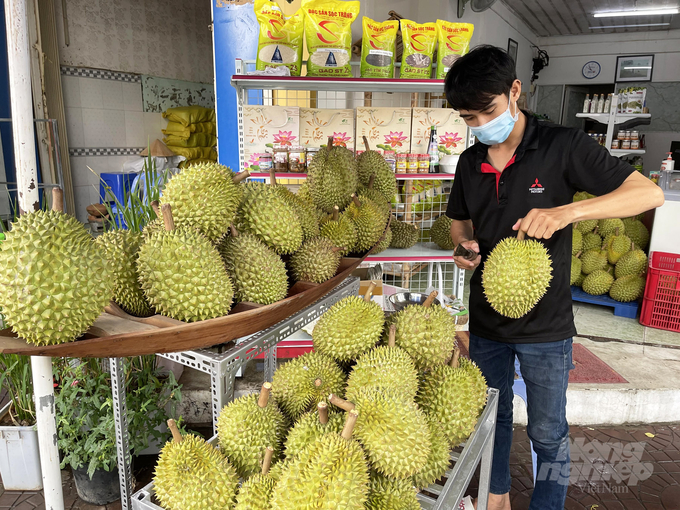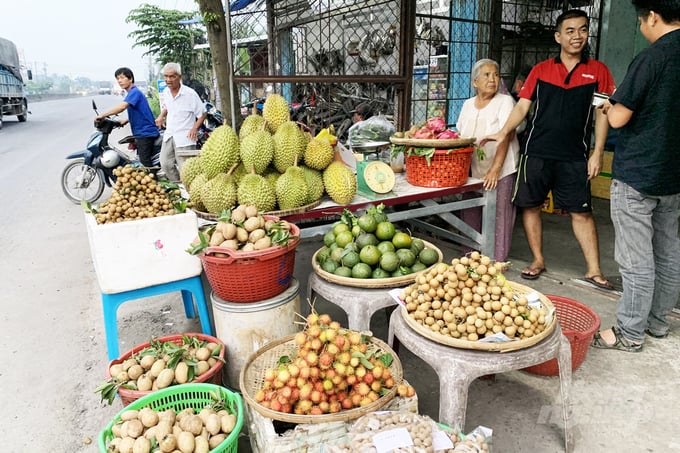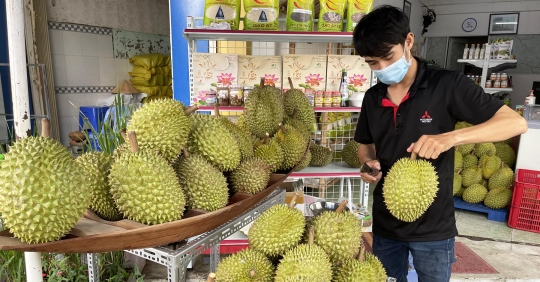Tet market is over, look at the fruits that have conquered the market and sold at the same price as delicious green-skinned grapefruit, five-rod, mango; Hoa Loc, Cat Chu… Gardeners say it’s because few goods go to market so price is good and some varieties like tangerines are thrown to market; Bananas, plums, guavas, oranges… wait until the market is still empty after Tet.
However, the people who trade the cotton (the way vegetables, tubers, and fruits are named and sold) that run the domestic market said it would be difficult to fully appreciate the market for fruit consumption just by looking at the purchasing power of the Tet market considered. Fruit products in the West are varied and plentiful. As soon as the fruit and vegetable processing industry does not do much, the fruit season goes from the beginning of the season to full maturity, at the end of the season it is mainly sold fresh, the price fluctuates like a regular sine cycle.

Phong Dien Durian is sold on Can Tho Market Street. Picture: Hu Duc.
To avoid this weakness, the techniques and skills of gardeners today can handle flowering, off-season fruiting, and planting plants to sell at a high price, targeting mainly a few varieties of delicious fruit. transported to distant markets and above all the market is relatively stable.
The rest, some hard-to-preserve fresh fruits, are mostly sold in local low-value markets. The group of fruit products of this kind is small, scattered, and the production is not large, such as B.: plums, guavas, sapodillas, tangerines… Earlier this year, when the ripe fruit season came back to the market, the price dropped Some varieties are harvested in the garden and sold for only 4-5 thousand VND/ kg sold.
Many gardeners still remember a time after the advent of the longan tree, the movement to plant oranges “on the side” and sell fruit at a good price. There is a commune in Chau Thanh district of Hau Giang province where many gardeners are collecting hundreds of millions of dongs, even billions of dongs, building houses with roofs and walls and making the whole village rich. The fever led some local farmers to bring oranges to be planted as vegetables to share their worries. Currently, the consequences can be seen, recent news story Oranges in Tam Binh (Vinh Long) sell cheap foam. In recent days, a trader working in the garden in Thoi Lai, Can Tho City, called his acquaintances to “save” big, delicious, sweet oranges and brought them to the point of sale for only VND 7,000/kg.
Currently, in the western provinces, mangoes and milkweed are in the end of the season, followed by the upcoming season of mangosteen and durian. After January’s cold weather for more than a dozen days, the sun was as hot as a hot breeze blanketing the durian gardens. Durian growers grew impatient when they heard that the door to the export market to China had opened earlier this year. Traders and a number of private companies supplying fruit to the southern provinces have eagerly joined. Some companies investigate planting plots to order, find co-ops to sign them up and promise to sell them.
Currently, most of the peak season durian gardens in Hau Giang, Can Tho City have only flowered and pollinated, and it is estimated that it will take about 100 days to fully mature. Currently, there are a number of gardeners who grow durian in the off-season, collect ripe fruits, sell them at high prices and make a profit, like winning the lottery.
A trader in the Phong Dien (Can Tho) garden collects durian for export to China and on February 23 updates the latest purchase price: Thai durian (from 7 to 8 years old) grade A costs 140,000 VND/kg, fruit size from 2 to 5, 5 kg/left (left 2.7 drawers or more); Type B costs VND 120,000/kg, the fruit size is between 1.8 and 6 kg/fruit (leaving 2.5 boxes or more). Ri6 durian, grade A costs 110,000 VND/kg, fruit size 1.8 – 5kg/rest (rest 2.7 boxes or more); Type B costs 90,000 VND/kg, fruit size 1.6 – 5.5 kg/left (left 2.5 boxes or more).

Retail fruit on the west highway. Picture: Hu Duc.
Although the price of durian is currently “conspicuous”, traders who buy durian in the Mekong Delta think that durian prices go up and down, continuous fluctuations are quite normal. Export goods that have to be packed in containers are bought cheaply. For example, on February 23, Ri6 durian was valued higher than on February 17, rising to VND5,000/kg. But now the price of fruit in the off-season and early season will be different than in the high season.
Finally, the fruit price goes up and down, the good season – the bad season… depends on the market. Moreover, although today’s gardeners are sensitive to monitoring the market through many information channels, it is easy to lead to wrong and divergent predictions once they receive incomplete and inaccurate information. Especially in the situation that hot sauce durian products are highly competitive both quantitatively and qualitatively in a number of countries with large growing areas.
In October 2022, the Department of Agriculture and Rural Development approved the decision to develop key fruit trees by 2025 – 2030. 14 tree species with high export sales were selected to focus on development. According to this, by 2025, the whole country will have 1.2 million hectares of fruit trees with a yield of over 14 million tons. In particular, the main fruit tree covers 960,000 hectares with a production of 11-12 million tons. The export turnover of fruit trees reached over USD 5 billion.
By 2030, the country will have 1.3 million hectares of fruit trees with a production of over 16 million tons. Export sales reached 6.5 million USD. For each large fruit tree, the scope of the concentrated production area is clearly defined with the planting area code, forming a chain of fruit tree production links from the planting area to processing and consumption products.

